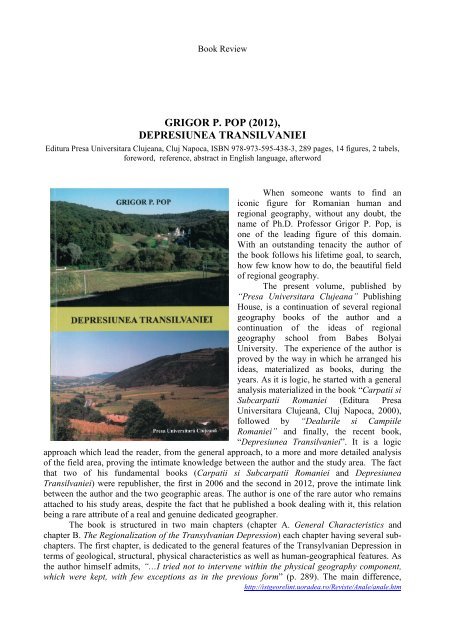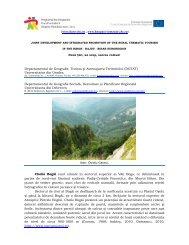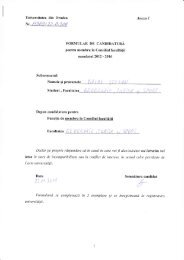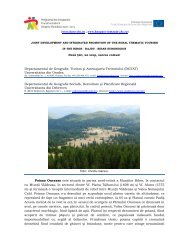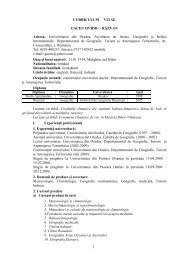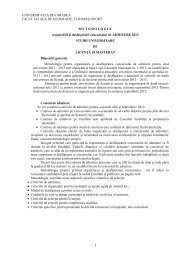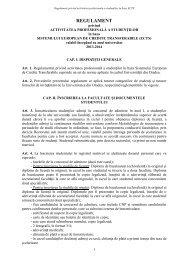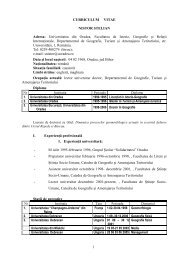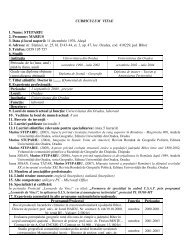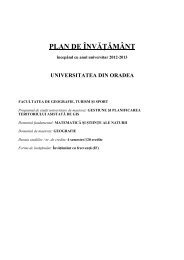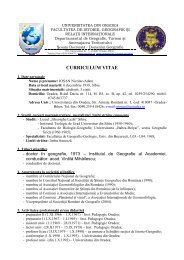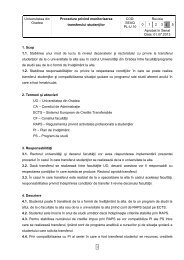GRIGOR P. POP (2012), DEPRESIUNEA TRANSILVANIEI
GRIGOR P. POP (2012), DEPRESIUNEA TRANSILVANIEI
GRIGOR P. POP (2012), DEPRESIUNEA TRANSILVANIEI
You also want an ePaper? Increase the reach of your titles
YUMPU automatically turns print PDFs into web optimized ePapers that Google loves.
Book Review<br />
<strong>GRIGOR</strong> P. <strong>POP</strong> (<strong>2012</strong>),<br />
<strong>DEPRESIUNEA</strong> <strong>TRANSILVANIEI</strong><br />
Editura Presa Universitara Clujeana, Cluj Napoca, ISBN 978-973-595-438-3, 289 pages, 14 figures, 2 tabels,<br />
foreword, reference, abstract in English language, afterword<br />
When someone wants to find an<br />
iconic figure for Romanian human and<br />
regional geography, without any doubt, the<br />
name of Ph.D. Professor Grigor P. Pop, is<br />
one of the leading figure of this domain.<br />
With an outstanding tenacity the author of<br />
the book follows his lifetime goal, to search,<br />
how few know how to do, the beautiful field<br />
of regional geography.<br />
The present volume, published by<br />
“Presa Universitara Clujeana” Publishing<br />
House, is a continuation of several regional<br />
geography books of the author and a<br />
continuation of the ideas of regional<br />
geography school from Babes Bolyai<br />
University. The experience of the author is<br />
proved by the way in which he arranged his<br />
ideas, materialized as books, during the<br />
years. As it is logic, he started with a general<br />
analysis materialized in the book “Carpatii si<br />
Subcarpatii Romaniei (Editura Presa<br />
Universitara Clujeană, Cluj Napoca, 2000),<br />
followed by “Dealurile si Campiile<br />
Romaniei” and finally, the recent book,<br />
“Depresiunea Transilvaniei”. It is a logic<br />
approach which lead the reader, from the general approach, to a more and more detailed analysis<br />
of the field area, proving the intimate knowledge between the author and the study area. The fact<br />
that two of his fundamental books (Carpatii si Subcarpatii Romaniei and Depresiunea<br />
Transilvaniei) were republisher, the first in 2006 and the second in <strong>2012</strong>, prove the intimate link<br />
between the author and the two geographic areas. The author is one of the rare autor who remains<br />
attached to his study areas, despite the fact that he published a book dealing with it, this relation<br />
being a rare attribute of a real and genuine dedicated geographer.<br />
The book is structured in two main chapters (chapter A. General Characteristics and<br />
chapter B. The Regionalization of the Transylvanian Depression) each chapter having several subchapters.<br />
The first chapter, is dedicated to the general features of the Transylvanian Depression in<br />
terms of geological, structural, physical characteristics as well as human-geographical features. As<br />
the author himself admits, “…I tried not to intervene within the physical geography component,<br />
which were kept, with few exceptions as in the previous form” (p. 289). The main difference,<br />
http://istgeorelint.uoradea.ro/Reviste/Anale/anale.htm
Book Review 355<br />
compared to the first edition, is related to the human components, the author tried to update the<br />
main human geography components (population, settlements, agriculture, industry, means of<br />
communication), to the data of 2010.<br />
The bulk of the book is dedicated to the Regionalization of Transylvanian Depression, (p. 33 -<br />
262) each main sub-division of the study area being separately analyzed both from physical and<br />
human aspects. One of the most important features of this chapter is related to the fact that the author<br />
successfully manages to link the analyzed Peripheral Units (p. 37 - 126) to the Carpathian, creating<br />
thus a logical causal explanation of a much larger geographical space.<br />
Probably the most important feature of the book, viewed as a whole, is given by the fact<br />
that it is perfectly balanced in terms of different geographic components. The analysis of physical<br />
components are perfectly linked to the human components, among them being a fluent<br />
penetration, the reader having the impression of fluency, the detail elements being perfectly<br />
integrated within different components. The analysis manner filtered by these scientific<br />
approaches reflects both originality and realism and also a very deep knowledge of geographical<br />
scientific literature. But the essence of this book is given by the experience of the author, the way<br />
in which he was able to filter, to integrate and to synthesize the data, the result being a scientific<br />
book with a unique individuality.<br />
The graphic of the book is simple but very clear, easy to read and to interpret, the<br />
reader having the opportunity to “anchor” different units, with the help of the maps, into o<br />
coherent visual matrix.<br />
The very comprehensive English language summary (p. 264 - 277) turn the book into a<br />
very usefull instrument for all those interested to find geographic information about this part of<br />
Romania and also integrate the book into international scientific circuit.<br />
Lector. univ. dr. Stelian NISTOR<br />
University of Oradea


